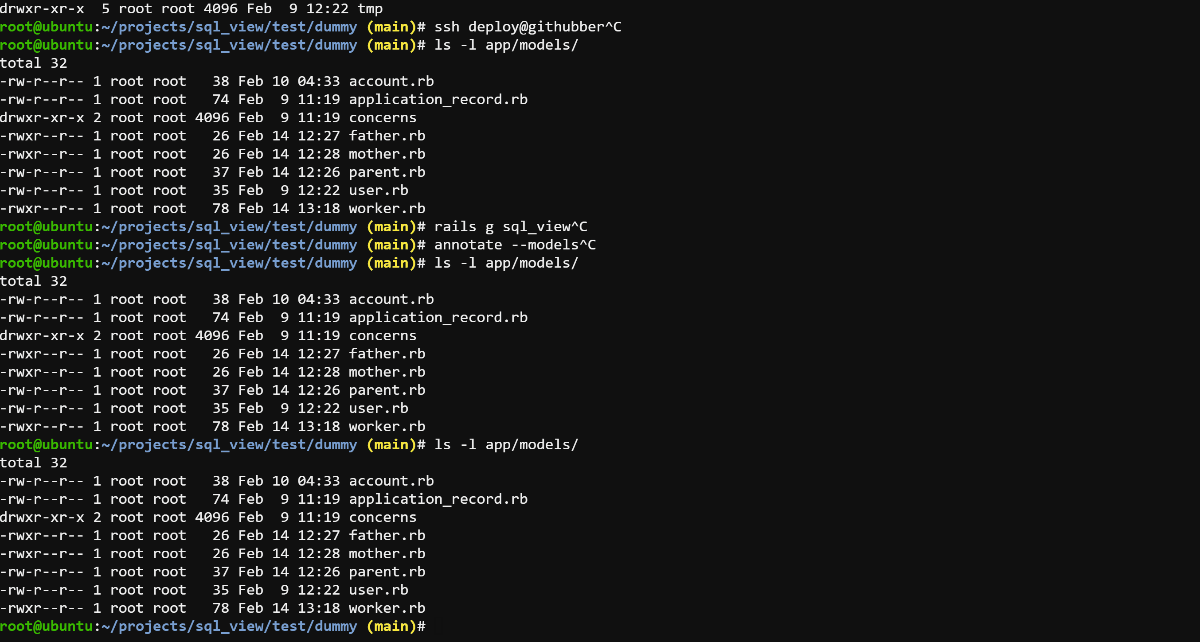If you are lazy and don't like to write SQL to create SQL view but you know AR use your skills to create views.
Production-ready.
The most simple way to add a view is to call a generator (examples below):
rails g sql_view:view DeletedProjects 'Project.only_deleted'
rails g sql_view:view ActiveUsers 'User.confirmed.where(active: true)' --materializedDepending on whether you need a materialized view or not add --materialized flag (later you can change in "view" class). Materialized views works in Postgres.
Generator will create a file similar to:
class ActiveUserView < SQLView::Model
materialized
schema -> { User.where(age: 18..60) }
extend_model_with do
# sample how you can extend it, similar to regular AR model
#
# include SomeConcern
#
# belongs_to :user
# has_many :posts
#
# scope :ordered, -> { order(:created_at) }
# scope :by_role, ->(role) { where(role: role) }
end
endor if you want to use SQL to create a regular view:
class ActiveUserView < SQLView::Model
schema -> { "SELECT * FROM users WHERE active = TRUE" }
endor the same but materialized:
class ActiveUserView < SQLView::Model
materialized
schema -> { "SELECT * FROM users WHERE active = TRUE" }
endLater with view you can work same way as with any model(ActiveRecord class). For example:
ActiveUserView.model.count
# or
ActiveUserView.count
# ----
ActiveUserView.find(42)
# you can apply scopes, relations, methods, BUT add them in extend_model_with block
ActiveUserView.model.by_role("admin").count
ActiveUserView.where(role: "admin").exists?
ActiveUserView.model.includes(:profile)If you need to refresh materialized view - ActiveUserView.sql_view.refresh (if you need to do it concerrently - .refresh(concurrently: false).
It can also be used with your other models:
class Account < ApplicationRecord
has_many :users
has_one :account_stat_view, class_name: AccountStatViewView.model.to_s, foreign_key: :account_id
has_many :active_users, join_table: :active_users_views, class_name: ActiveUserView.model.to_s, foreign_key: :account_id
endMore examples in this file: ./test/sql_view_test.rb
gem "sql_view"And then execute:
$ bundleAnd use generator. Or you can connect it to existing view with view_name=:
class OldUserView < SqlView::Model
self.view_name = "all_old_users"
materialized
schema -> { User.where("age > 18") }
extend_model_with do
scope :ordered, -> { order(:id) }
def test_instance_method
42
end
end
end- add index
add_index SomeView.view_name, :user_id, unique: true- refresh with parameter
SomeView.sql_view.refresh(concurrently: true)- profit :)
- CI with different versions of Rails/Ruby
- make unit tests works with
rake test cascadeoption- move classes to own files
- code coverage
- verify how it works with other DB's
- check if schema was changed on migrate or schema dump?
ruby ./test/sql_view_test.rb (because somehow rake test not works, not critical for now)
You are welcome to contribute.
I know about and actually using gem scenic, which is very nice and I tool some examples from it how to dump view into schema.rb but this gem was created to simplify life and reduce amount of time needed to write SQL to create a sql view.
The gem is available as open source under the terms of the MIT License.

